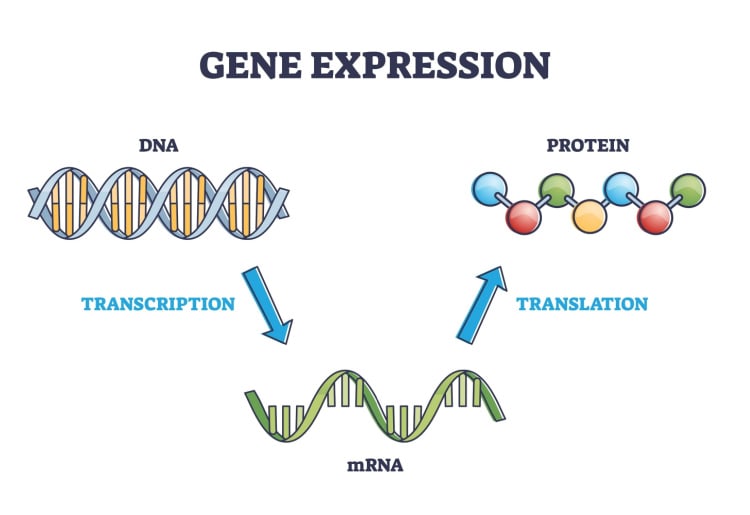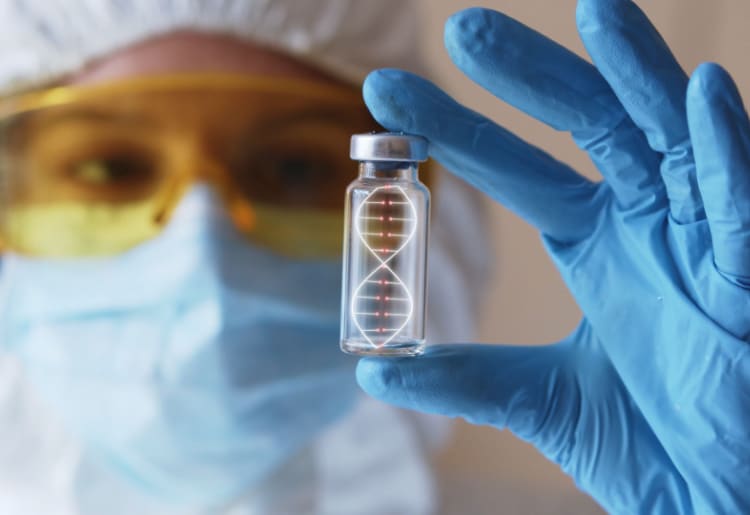When it comes to understanding how your body works, DNA testing is essential as it analyzes your genes down to the building blocks—DNA and RNA.
DNA and RNA are nucleic acids, made of nucleotide sequences, sugar-phosphate structures, and four nitrogenous bases. DNA is a self-replicating molecule that carries hereditary information needed for the growth and maintenance of your cells. RNA is a large molecule that turns that information into proteins.
Here, mutations can have a severe impact, which is one of the reasons for taking a DNA test and checking your genetic risk factors.
In this article, we'll explain the difference between important DNA terms and outline ten key differences in their functioning.
» Already have a DNA test done? Here's how to read the results.
Proteins and Nucleic Acids: What You Need to Know
Nucleic acids, comprising DNA and RNA, are the genetic scripts of our cells. They are long chains of nitrogen-containing bases, ribose sugars, and phosphate groups called nucleotides.
Proteins carry the information written in these acids. While DNA replicates genetic information, RNA facilitates protein synthesis via translation. Both acids play similar roles but have distinct properties.

How Do DNA & RNA Really Differ?
1. Helix Structure
DNA DNA is renowned for its iconic double-stranded helix structure, where the molecules resemble a twisted ladder. In contrast, RNA forms an alpha-helix structure with its single-stranded configuration. These unique structures define their appearance and play a crucial role in their respective functions.
The DNA molecule's double helix structure makes it easy to replicate and aids protein synthesis. The alpha-helix structure of the RNA is responsible for shaping the secondary structures during synthesis.
2. Nucleotide Composition
While both DNA and RNA are composed of nucleotides, they differ in their sugar components and nucleobases. Specifically, RNA contains ribose sugar and uracil nucleobase, while DNA contains deoxyribose sugar and thymine nucleobase.
This distinction becomes evident during transcription when DNA's double helix separates, and uracil takes the place of thymine in the newly formed RNA strands.
3. Function
Analyzing nucleic acids' structure and composition makes their different functions apparent. As shown in a 2019 Biochemistry Essay, the DNA carries the genetic code for protein sequencing, while the RNA copies those codes and translates them into proteins.
DNA carries the instructions on how to develop, survive, and reproduce, and with that, it proves that our traits are tied to genetics.
4. Length
One of the striking differences between DNA and RNA is their length. DNA, with its expansive structure, is considerably longer than RNA. To illustrate, the human body consists of 23 chromosome pairs, with each DNA strand spanning approximately about 250 million nucleotide pairs, while an RNA strand typically measures only a few thousand.
When fully extended, a single DNA molecule can reach up to 2 meters, whereas an RNA molecule, with its intricate three-dimensional folds, is just 1-2 nanometers in length.
5. Location
The cellular locations of DNA and RNA further differentiate them. DNA predominantly resides in the cell's nucleus, with a small portion found in the mitochondria, known as mitochondrial DNA. On the other hand, RNA originates in the nucleolus and then journeys to the cytoplasm, where it plays a role in protein synthesis.
An intriguing observation from a Scanning Transmission Soft X-Ray Microscopy (STSXM) study revealed that RNA surrounds the DNA molecule at the chromosome's core.

6. Ultraviolet Sensitivity
DNA and RNA exhibit different sensitivities when exposed to ultraviolet (UV) light. RNA showcases a higher resistance to UV damage compared to DNA, which can be attributed to its molecular structure. This resistance is particularly significant as it reduces the likelihood of mutations in crucial genes like tumor suppressors and proto-oncogenes.
The extent of damage to the DNA depends on the wavelength of the photon—usually around 300-305 nanometers. Meanwhile, the presence of uracil in RNA acts as a protective shield, preventing certain types of UV-induced damage.
7. Base Pairing
Base pairing is a fundamental concept in genetics, and both DNA and RNA exhibit specific patterns. In DNA, adenine pairs with thymine (A-T), and guanine pairs with cytosine (G-C). RNA follows a similar pattern, but adenine pairs with uracil.
The RNA molecule has a weaker backbone structure, is less resistant to mutation, and contains uracil, which is short-lived. Meanwhile, the DNA molecule's use of thymine instead of uracil makes it more stable, resistant to mutation, and able to self-repair.
8. Replication And Repair
DNA molecules have the ability to self-replicate. They multiply rapidly using the enzyme DNA polymerase, replicating billions of copies within hours. In RNA, transcription forms complementary mRNA copies using DNA as a template.
DNA has pathways that repair, tolerate, and remove damage via cell death. Although RNA repair is yet to be understood, recent research shows that ribonucleases degrade damaged RNA and remove it from the cell to avoid further damage.
9. Mutation Rate
Compared to DNA, RNA has a higher mutation rate, which can be attributed to the weakness of its backbone structure and the reactivity of the RNA molecule.
For example, DNA viruses typically have a mutation rate of 10-6 to 10-8 mutations per nucleotide, while RNA viruses have a rate of 10-3 to 10-6 mutations per nucleotide.
RNA viruses have a higher mutation rate because their polymerase enzymes lack proofreading abilities. This proves to be positive as scientists have found a way to deplete RNA viruses by inducing artificial mutations, potentially leading to their extinction.
» Inform yourself about the most common genetic disorders.
10. Reactivity
The chemical reactivity of DNA and RNA stems from their molecular components. RNA's ribose has an additional hydroxyl group, making it more prone to reactions like hydrolysis. Additionally, uracil in RNA is notably reactive. In contrast, DNA's deoxyribose sugar forms a more rigid structure, and the presence of thymine further enhances its stability, reducing its overall reactivity.

Understanding Your Genes
DNA and RNA form your genetic makeup, and if you'd like to understand your genes and associated risk factors, genetic tests are the way to go. Companies like Vitagene offer insights into optimal nutrition and lifestyle choices based on your genes, while Futura Genetics can assess your genetic predisposition to 28 common diseases.
It's crucial to remember that any lasting mutation in your DNA can influence cellular growth and hereditary traits.
» Did the article spark an interest in DNA testing? You can compare the best DNA test kits and their price rates.

